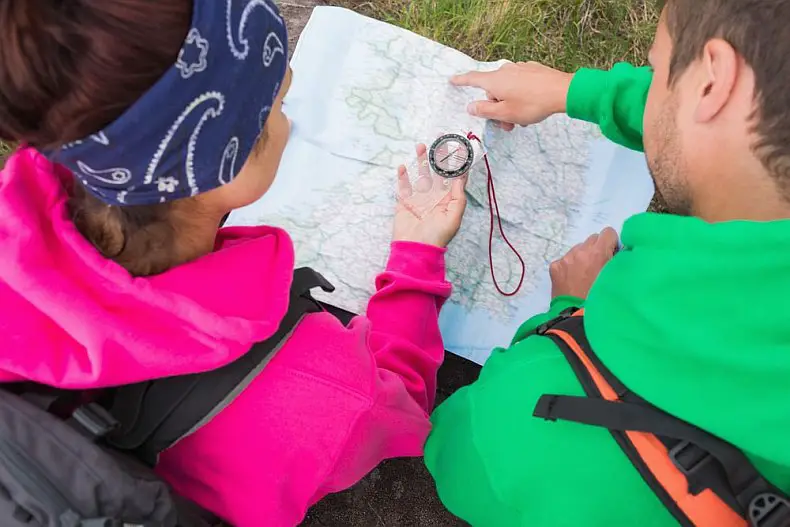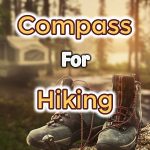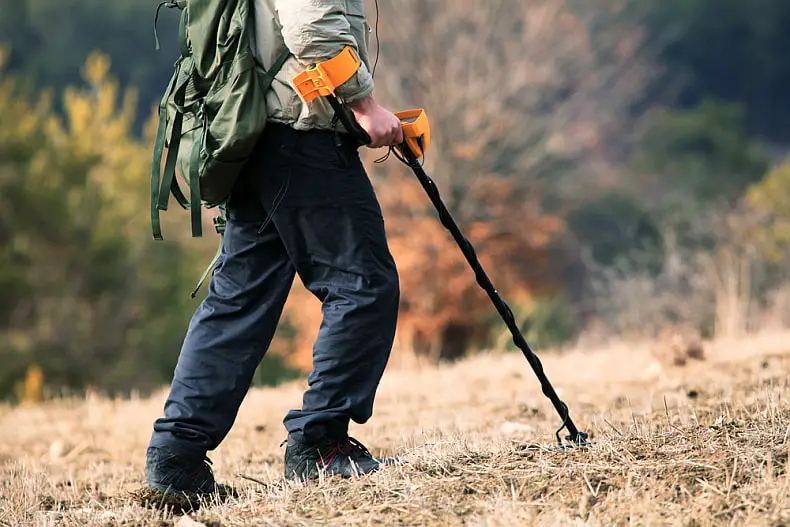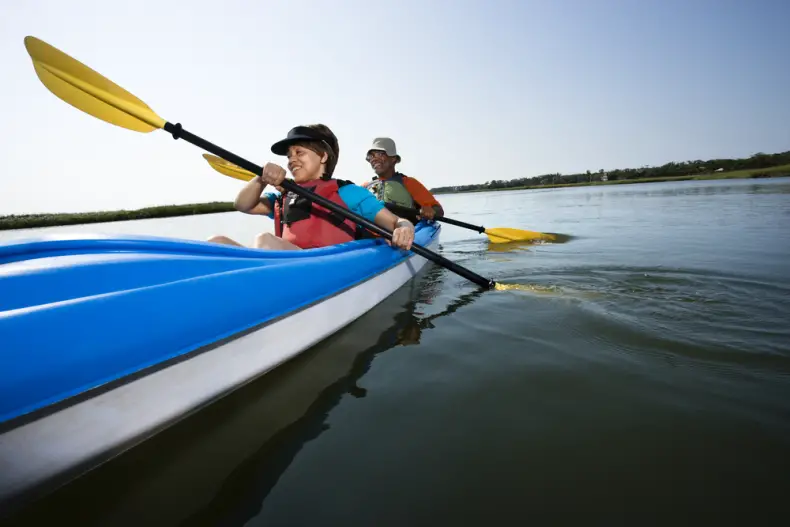Whether, hiking, backpacking, or camping, the ability to navigate outdoors is a fundamental ability you need to have. Even with the availability of the GPS, the tool of choice for many is still the compass. Yet many people do not know how to properly use a compass, even those who own one.
In this post, we’ll fully cover everything you need to know for using a compass and a map to navigate outdoors.
Table of Contents
History Of The Compass
The magnetic compass was invented in China between 206 BC and 220 AD (the Han dynasty), a period of economic prosperity as well as significant advances in science and technology. It was made using lodestone, a naturally magnetic rock mineral.
Later during the Song dynasty (960-1279), the first magnetic needle compass was made by a successful scientist by the name of Shen Kuo. To accomplish this he rubbed the needle with a lodestone to magnetize it and then suspended it with a piece of silk. Not yet fully understanding magnetism, Shen Kuo noted that sometimes the needle would point south, and sometimes it would point north.
It is unclear whether the magnetic compass was also developed in Europe or was brought from China. In any case, the compass was used for navigation during the late thirteenth century in the Mediterranean region.
The compass rose which illustrates the cardinal directions north, south, east, and west became an integral part of the magnetic compass. Compasses today show degree markings for a full 360 degrees, and many still display the rose.
Compass vs A GPS Device

GPS devices are great – no doubt about it. In fact, I have one and I don’t discourage anyone from buying one. They are awesome tools for navigation.
They are not without limitations, however. Below are some cons to the GPS device:
- A GPS device relies on battery power. The battery in my device lasts a good while. But with a dead battery, it becomes useless. If you are going to rely solely on your GPS for navigation, I highly suggest new batteries or carrying a spare set, especially if they have sat in the device for some time.
- It is subject to breakage. Anything can break. But a GPS device will generally be more susceptible to breaking when dropped and banged around than a compass.
- It relies on satellite signals. In situations where there is little or no signal, your GPS device may be prone to errors or not working at all.
- Expense. You’ll pay considerably more money for a GPS device than a compass. Even the low-end models will hit your wallet pretty hard compared to a high-end compass.
The takeaway here is to always carry a compass and know how to use it regardless of whether or not you use a GPS device. A compass does not rely on battery power, is fairly rugged, requires no signal – only magnetic north, is a fairly inexpensive tool, and is always reliable.
Parts Of A Compass
Before we actually dive into using the compass, it’s important to be able to know the anatomy of a compass and what the various parts do. Refer to the image of the baseplate compass below.
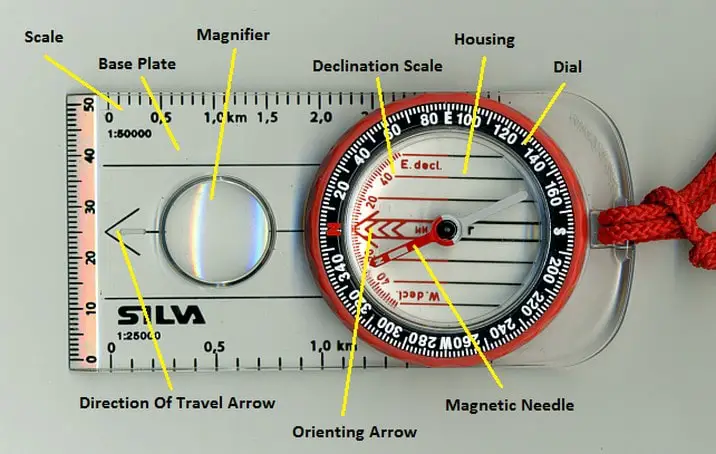
- Base Plate
The base plate is the flat base made of clear plastic which all other components are attached to. The base plate sits on the map when taking a bearing. - Housing
The compass housing covers the compass needle and is usually liquid-filled. - Dial
The dial is a rotatable ring with degree markings from 0 to 360 degrees. - Magnetic Needle
The magnetic needle is the magnetized needle that points to magnetic north. - Declination Scale
The declination scale consists of degree markings which allow for compensating for the difference in magnetic north and true north. - Direction Of Travel Arrow
The direction of travel arrow points away from the compass and toward your destination. - Orienting Arrow
The orienting arrow is used to align with the red end of the magnetic needle in order to correctly orient the compass. - Scale
The scales on the edges of the compass are used to measure distances on a map. - Magnifier
The magnifier is used to magnify smaller features on a map for better viewing.
Navigating With The Compass
To use a compass for navigation, the first thing you will need is a map. You can download US topographical maps for free at USGS.
Magnetic Declination
Let’s talk a little bit about something called magnetic declination. Declination is the difference between true north and magnetic north.
True north is the northern axis on which the earth rotates. Magnetic north is where the compass needle points due to the earth’s magnetic field.
These two norths are different (usually). If you happen to be in the specific ideal location (unlikely), true north and magnetic north could line up together and both point in the same direction.
Declination is actually the angle between true north and magnetic north, so this difference is expressed in degrees.
In areas where declination is small and your trip is short, declination may not be a real factor. But several degrees declination with a long trip can put you WAY off course if you don’t compensate for it.
Some compasses have a declination adjustment where it can be set to compensate for the variation between magnetic north and true north automatically. If you have one of these compasses you’ll need to set this first per the manufacturer’s instructions.
The amount of declination depends on where you are on earth. Since magnetic north is constantly changing, it’s important to get the most up-to-date declination for your area. You can get your most current declination at NOAA.
If your compass has “fixed” declination correction or a “declination scale”, you can skip this part for now. We’ll compensate for declination later.
Taking A Bearing
The first thing we need to do is take a bearing. We do this with the help of our map and the edge of our compass with the scale markings.
Lay your map on a flat surface and find your location. Align the edge of your compass with the point you are at and the point you want to go. We’ll call this point A and point B. If it helps you can draw a line with a pencil.

Once your compass edge is correctly spanning from point A to point B, press the compass firmly on the map and rotate the dial until the orienting arrow and “N” point to grid north (parallel with vertical grid lines).

If your compass has fixed declination compensation, now is the time to adjust for it. You’ll have to adjust either east or west depending on where you are located on earth.
Let’s assume you are on the US east coast and you looked up the declination for your area and it was 7 degrees W. If you follow the compass needle (magnetic north) it will actually be pointing 7 degrees west of true north. You would need to rotate your compass dial 7 degrees clockwise. Many compasses will have a scale specifically for this to make it easier.
Once you adjust for declination, you’ll notice that your orienting arrow is no longer aligned with the “N” marking. This is not a problem. You should now be adjusted for magnetic declination.
If you are using a compass without a declination scale or adjustable declination, you’ll have to do the math and either add to or subtract from your bearing and use that as your true bearing.
Red In The Shed
Now you are done adjusting the dial. Be sure and not to rotate the dial at this point. Hold the compass level and rotate the compass to align the needle with the orienting arrow. This is known as “putting red in the shed”. The direction of travel arrow at the front of the compass will now point in the direction of your desired travel and your bearing in degrees will be aligned with it.
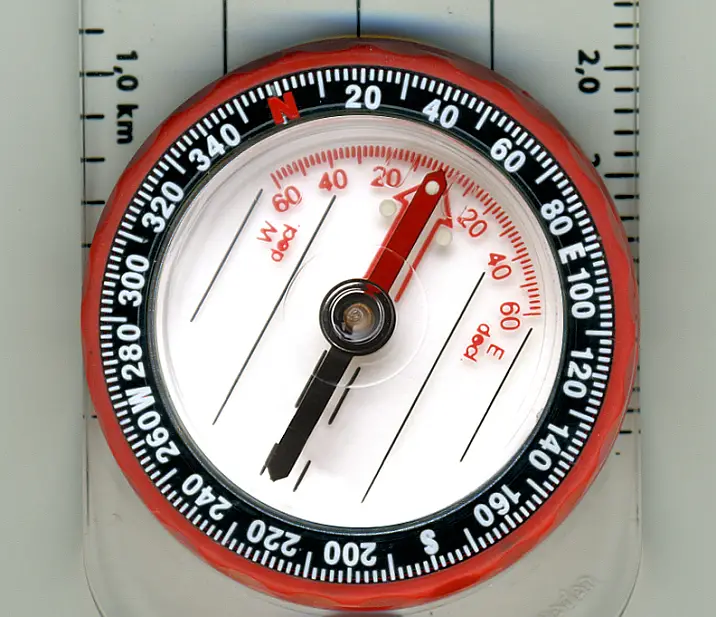
The best way to travel is to spot a fixed object in the distance that aligns with the direction of travel arrow and walk towards it instead of constantly looking at your compass. When you reach that object you can realign and spot another object.
Conclusion
Navigating with a compass will always be a fundamental skill everyone in the outdoors should possess. There is nothing wrong with using a GPS device. Like I said before, they are great. But don’t rely solely on it. Always carry a compass and practice to become proficient with navigating with it. You might not use your compass on a regular basis, but you never know when it could save the day – or your life!

